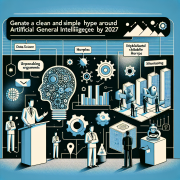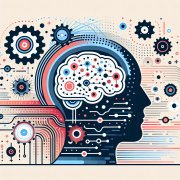Artificial Intelligence: The Current Reality a…
Artificial Intelligence: The Current Reality and Challenges for the Future
In recent years, the rise of artificial intelligence (AI) has triggered both excitement and concern in equal measure. Major breakthroughs such as machine learning and data-driven algorithms have reshaped industries and are on the verge of completely upending how we interact with the world. However, despite the monumental progress, I believe it’s important to maintain a balanced perspective, especially given AI’s current limitations and the immense potential it holds in reshaping our daily lives and economic systems.
AI Isn’t What You Think: Why It’s Not “Thinking” Yet
It’s a common misconception that artificial intelligence functions like a human mind—capable of creative thought, emotions, and generalized intelligence. The reality, however, is significantly different. As previous articles on my blog have discussed, while AI can now perform remarkably well in specific areas—such as facial recognition, translation, or even driving a car—its intelligence is still narrow and task-specific. The technology we are dealing with today is driven primarily by machine learning, where complex algorithms sift through massive amounts of data to identify patterns and execute decisions based on those patterns.
Kaiu Lee, an industry expert, has suggested that while we’ve made unprecedented progress in AI, the common ground of understanding AI across the masses is either limited or riddled with misconceptions. In essence, what we call AI today isn’t anywhere close to what humans consider ‘intelligence.’ It doesn’t think or understand; it simply analyzes data and applies the rules learned from that data.
Deep Learning: A Data-Driven Approach
One of the biggest innovations propelling AI is the advent of deep learning. Rather than manually programming all the intricate rules (as was done early in AI development), today’s systems “teach” themselves through exposure to massive datasets. For instance, if you wanted a system to recognize cars, you wouldn’t hand-code the characteristics of different car models. Instead, you’d feed the AI millions of car images so it could find the distinguishing features on its own.
This approach, however, is not without significant limitations. AI’s immense effectiveness in specialized tasks arises from the brute force of data rather than true understanding. For example, while an AI system may accurately distinguish between a pickup truck and an SUV based on millions of image examples, it cannot extrapolate that knowledge to distinguish between a chair and a bed unless it has been trained for that specific task.
The recurring issues with hallucination—when AI confidently outputs entirely fabricated information as fact—complicate things even further. This should prompt us to reinforce checks and balances in AI applications, especially when dealing with sensitive tasks such as medical diagnosis, financial decision-making, or autonomous driving.
Societal and Ethical Implications of AI: More Than Just Technical Challenges
Many industries—from healthcare to automotive—are on the verge of being completely transformed by AI. A recent exploration I did on autonomous vehicles delves into how self-driving cars are influenced heavily by AI-powered decision systems. However, we must consider the broader societal implications. Across multiple sectors, AI promises increased efficiency but also job displacement on an unprecedented scale.
Kaiu Lee has pointed out that up to 40% of jobs could be displaced by AI within 15 years. It’s not just manual labor at risk. White-collar jobs such as those held by lawyers, accountants, and even writers are now being assisted or replaced by machines, complicating the traditional notions of job security in modern economies.
China and AI: The Unstoppable Force?
One particularly interesting aspect of AI development is the geopolitical shift that’s occurring, with China emerging as one of the leading forces in AI innovation, particularly in capitalist ventures. Companies such as Face Plus+ have become pioneers in AI-driven facial recognition and surveillance systems, fueling China’s rapid advancements in smart city infrastructure and technological dominance. Despite privacy concerns raised by Western democracies, China’s access to over a billion citizens’ worth of data has allowed their AI programs to excel in ways unattainable yet for others.
“The more data you have, the smarter your system becomes,” Lee commented. China, with its massive population and fewer restrictions on data collection, has a monumental advantage in this new global race.
Part of the challenge humanity faces moving forward will involve developing regulatory frameworks and ethical best practices, ensuring AI is used responsibly. While the Chinese approach capitalizes heavily on data availability and rapid development, privacy concerns must not be dismissed. In the West, we’ve already seen how misinformation can easily spread via AI, such as with recent concerns over AI systems ‘hallucinating’ or promoting fake news.
AI’s Future: Caution in Optimism
Despite all the excitement AI brings, it’s critical to be mindful of what AI cannot yet solve. General AI—systems that can think, reason, and adapt to new situations like humans—is far from reality. Many experts in the field, myself included, tend to agree that the timeline for developing Artificial General Intelligence (AGI) isn’t one measured in years, but potentially decades or longer.
Another dimension that requires further thought is AI’s potential for bias. Given that machine learning models are inherently dependent on their training data, they absorb and potentially magnify biases present in those datasets. These biases can, and have, led to moral and ethical dilemmas ranging from biased hiring tools to problematic law enforcement technologies.
“It’s not general intelligence like that of a human… this system can read faces and grade papers, but it has no idea why these children are in this room or what the goal of education is,” I wrote in a past article analyzing AI’s flaws.
Conclusion
In the end, we are at the genesis of a new reality shaped by AI. Whether used in tutoring systems that track students’ emotions or in autonomous-driving systems that could one day replace millions of chauffeurs and truck drivers, the pace of innovation is astounding, but the challenge lies in our ability to responsibly integrate these systems into human society.
I remain optimistic about AI’s ability to solve some of humanity’s biggest problems, from breaking down language barriers to discovering new medical insights. But I’m also cautious. We need to thoroughly understand what AI really is—an incredibly useful, yet incredibly limited tool. Balance is key, as is regulation. AI cannot be treated simply as an engineering problem. It’s a human problem, one that will continue to evolve well beyond the narrow confines of the technology sector.
Focus Keyphrase: Artificial Intelligence in China










Thank you. Nice article!
Just posted! What are your thoughts?